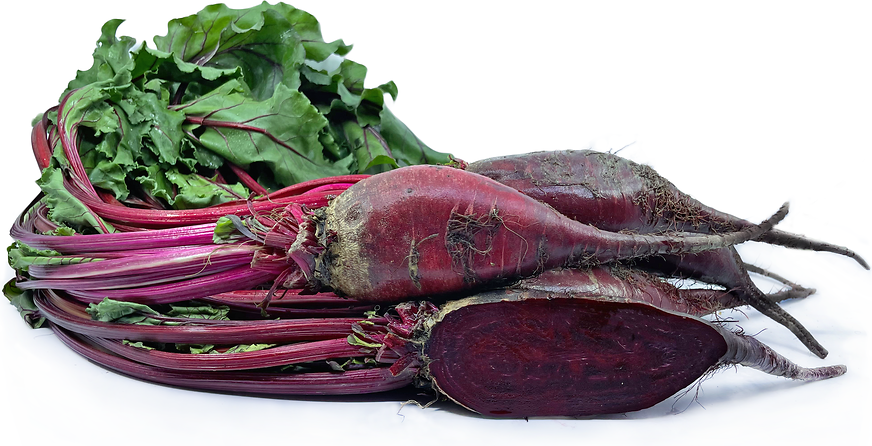


Red Forno Beets
Estimated Inventory, bunch : 0
Description/Taste
Red Forno beets are small to medium in size, averaging twelve centimeters in length and five centimeters in diameter, and are elongated, oval, to cylindrical in shape with one slender, tapered end. The roots are connected to long and crisp, multiple, maroon stems that are attached to deep green leaves with red veining. The root’s skin is semi-smooth, dark red, and firm with many small hairs covering the surface. Underneath the thin skin, the flesh is bright red to crimson, dense, and aqueous. Red Forno beets are crunchy when raw and when cooked, they develop a tender texture with a bold, earthy, and sweet flavor. The beet greens are also edible and have a semi-bitter taste similar to spinach and swiss chard.
Seasons/Availability
Red Forno beets are available year-round.
Current Facts
Red Forno beets, botanically classified as Beta vulgaris, are edible, underground roots that grow multiple, leafy stalks and are members of the Amaranthaceae family. Red Forno beets are a rare, European heirloom variety that is favored for its fine-grained flesh and mild flavor. Forno translates from Italian to mean “oven” in English, and while the exact reasoning behind this name is unknown, some experts believe it was given this descriptor because of the root’s popularity roasted or baked in the oven. Red Forno beets are used similarly to cylindra beets as a table variety and are utilized in everyday cooking.
Nutritional Value
Red Forno beets contain some potassium, copper, vitamin C, manganese, folic acid, and phosphorus.
Applications
Red Forno beets are best suited for both raw and cooked applications such as baking, braising, roasting, steaming, and boiling. It is important to note that the deep coloring of the root may stain skin, cutting boards, and clothing, so care should be taken to slice the beet and gloves may be an optimal choice for protection. The skin should also be removed before consumption and can be easily slipped off once cooked. Red Forno beets can be consumed raw and are popularly shaved into salads and soups, or they can be pickled for extended use as they have a uniform size when sliced. When cooked, Red Forno beets can be roasted with herbs as a tender side dish, pureed into sauces, cooked into pasta, sautéed into stir-fries, or cubed and served with rich meats. The leaves are also edible and can be lightly sautéed as a salad green or cooked as a braised green with main dishes. Red Forno beets pair well with cheese, bacon, prosciutto, smoked fish, eggs, shallots, dill, paprika, walnuts, garlic, chives, citrus, avocado, asparagus, arugula, spinach, and hazelnut and pistachio oil. The roots will keep up to two weeks with the leaves removed when stored in the crisper drawer of the refrigerator, and up to one week when stored with the tops still attached. Red Forno beet leaves will only keep 1-2 days after harvest when stored in the refrigerator.
Ethnic/Cultural Info
Red Forno beets are a rare variety to find in the commercial marketplace, but the root is often planted in home gardens favored for its uniform, cylindrical shape. The elongated beets can be planted close together and provide a higher yield in a smaller amount of space. Like the cylindra beet, Red Forno beets are commonly used for pickling and canning and are sliced using the Bias cut to increase surface area and reduce cooking time. Home chefs in the United States are also using the beets in creative ways such as coloring gnocchi and pasta or using the root in gazpacho.
Geography/History
The origins of Red Forno beets are native to the Mediterranean and Atlantic coasts of Europe and North Africa. Initially, the plant was cultivated for its leafy green tops and consumption of the root itself did not take place until the 1800s. The discovery of the beet's high sugar content also led to its increased agricultural value, spreading the root throughout the world via immigration and trade. Today Red Forno beets can be found at specialty grocers, farmers markets, and through online seed retailers in Europe, Africa, and the United States.
Recipe Ideas
Recipes that include Red Forno Beets. One
Podcasts




